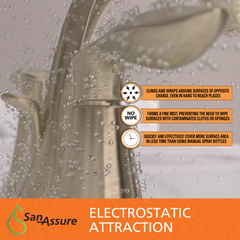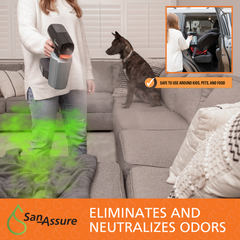
Residential, Commercial & Hospital Disinfectant

Mycotoxins are toxic compounds produced by certain types of fungi. These fungi can grow on various crops, including grains, nuts, and fruits, as well as in damp environments such as homes, restaurants, and agricultural settings. Mycotoxins can contaminate food and feed, posing a risk to human and animal health.
Mycotoxins can be found in a wide range of food products, including cereals, nuts, spices, dried fruits, coffee beans, and alcoholic beverages. They can also be present in indoor environments with high humidity or water damage, such as homes and restaurants. In agricultural settings, mycotoxins can contaminate crops during growth, harvest, transportation, and storage.
Places with higher humidity tend to be the perfect breeding ground for Stachybotrys chartarum (also known as “black mold”), which produces other families of mycotoxins.
When there is a mold infestation in a home or building, the contaminated areas also become breeding grounds for bacteria that produce toxins called endotoxins. The mold and bacteria infiltrate surfaces in the home and begin to release volatile organic compounds (VOCs), and this contaminated air circulates through the home or building.
With hundreds of thousands of unique mycotoxins, we won’t know for sure how many mycotoxins are harmful until the research has been done. According to the World Health Organization (WHO), there are currently a handful of mycotoxins of serious concern due to their severe effects on human health. These include:
Aflatoxins
Ochratoxin A
Patulin
Fusariums
Trichothecenes
You can take steps to help avoid exposure to mold and mycotoxins – and San-Assure is your secret weapon against both. San-Assure harnesses the power of oxygen – in the form of Chlorine Dioxide (ClO2) – to eliminate molds on a molecular level, neutralizing spores and inhibiting fungal growth without damaging the surfaces treated. San-Assure is also tested and proven effective in neutralizing a range of mycotoxins. Unlike traditional cleaners and disinfectants that are only effective on hard, non-porous surfaces, San-Assure can also penetrate surfaces like carpets, upholstery, drywall, grout, concrete, and wood – and destroy the roots of tough mold and mildew.
The moment you spot mold around your home, it’s time to take action. For small areas of household mold, first, find and repair any sources of excess moisture and make sure the room is adequately ventilated. Next remove all visible mold (a scrub brush, water, and San-Assure works well) and then thoroughly rinse with water. Finally, spray the affected area liberally with San-Assure (full-strength, do not dilute for mold removal) from a distance of 12 inches until visibly wet and allow it to air dry. San-Assure has a residual effect on mold and mold spores for up to one month on fabrics and one week on hard surfaces with a single treatment.
Using San-Assure to regularly clean and disinfect areas around the home that are often in contact with water (for instance, your shower and kitchen sink) can neutralize mold spores before they become an issue.
Keep in mind that mold infestations may not always be obvious. It’s essential to be mindful of signs pointing toward water damage (musty smells, staining, standing water, condensation, warped floor and walls, peeling paint, etc.). If you suspect an extensive mold infestation in your home, it’s best to hire a professional who is trained in mold cleanup. Some molds (and the mycotoxins they produce) are highly toxic. Even less dangerous molds can cause problems for people with allergies or those with compromised immune systems or respiratory issues.
Generally, the rule of thumb is to seek the help of a professional if the mold covers ten or more square feet, as removing large mold colonies requires specialized equipment and tools. Local public health departments can offer advice on mold testing and refer you to an expert mold remover. Always err on the side of caution when it comes to significant mold issues.
Search
About
Technology
Resources
Professional Use
Contact
Newsletter
Accessibility
Terms of Service
Refund Policy
Privacy Policy
Warranty Registration
San-Assure provides multi-surface cleaning solutions that allow you to disinfect and sanitize every surface in your home. Our EPA-Registered sanitizer is safe to use and our electrostatic attraction technology provide full coverage disinfecting.
*simulated image.







